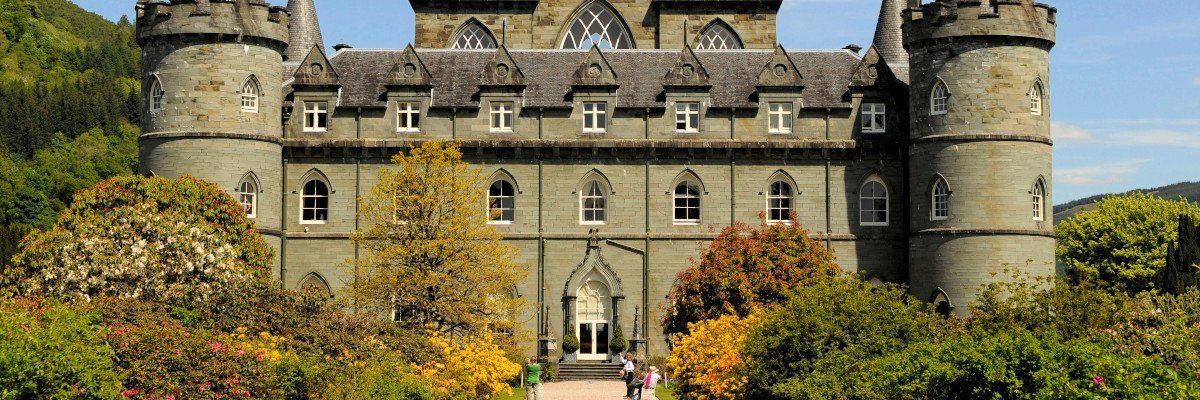
Inveraray is located on the shores of Loch Fyne, where it links with Loch Shira. The village, as it stands today, traces its origins back to the mid 1700s, when the 3rd Duke Of Argyll demolished an earlier small fishing village to accommodate his newly rebuilt castle (Inverary Castle). The original village of Inveraray was made a burgh of barony in 1472, and subsequently made into a royal burgh in 1648. Due to its location, lying at a key point in the limited road network, and with a good harbour, Inveraray had become the centre of the county by the 18th century. The 3rd Duke of Argyll inherited the castle when he succeeded to his title in 1743, but found the castle to be in ruins and uninhabitable. His response was to rebuild the castle and move the entire town further to the south.
Inveraray Castle is the reason many visitors arrive in the village each year, it is as impressive inside as it is outside, has a huge collection of historical weaponry and many fine antiques and furniture. Inverary is also a very attractive village, built originally along two streets, Front Street and Main Street, which are lined with large white-harled buildings. In the centre is Church Square, which accommodates Glenaray and Inveraray Parish Church, built between 1792 and 1802 by Robert Mylne, an Edinburgh Architect. Queen Victoria visited the village in 1847 and her daughter, Princess Louise, married the Marquis of Lorne in Inveraray Castle in 1875.
Those with historical interests may also enjoy visiting Inveraray Jail, which also dates back to the redevelopment implemented by the 3rd Duke. It is open daily throughout the year and comprises of a Georgian courthouse and prison blocks. The jail closed in the 1930s but in recent times has re-opened as a visitor centre and museum. In the museum prison conditions from medieval times up to the 1800s are described using interactive displays and live performances by actors. Not far to the south of Inveraray Jail and on the shore is the Para Handy Cottage, the birthplace of the author Neil Munro. The Inveraray Cross is located on the harbourside; it is a tall and beautifully carved stone cross dating back to the 1300s or 1400s and once served as the market cross of the original village (albeit in a different location).
Sadly The Inveraray Maritime Museum (which was located at the town pier) and comprised of two moored vessels ‘The Arctic Penguin’, a triple-masted schooner built in Dublin in 1911 and the steamer’ The Vital Spark’ are no longer open to the public. As these is such important attraction to the area it is hoped they will one day be re-opened. The Pier is now also closed to the public but it is hoped after some investment this will also re-open.
There are some excellent walks around Inveraray and one of the most stunning is the walk to the Watch Tower which offers great views of the town from the summit (248 metres, 813ft). The walk starts from the grounds of the Castle and is well signposted as The Dun Na Cuaiche Woodland Walk and is about 2.5 kms or 1.5 miles in length. It can be a little steep in places but the views from the top are well worth the effort. The tower itself was designed by Roger Morris and William Adam and was built in 1748. Its purpose was purely decorative and was cleverly sited on the edge of the steep face of the hill but not quite on top so that when seen from the Castle and Town it is silhouetted against the sky.
Inveraray has the following facilities
Explore Inveraray
Use the search feature below to explore accommodations, activities, attractions, and places to eat and drink, in and around Inveraray.
